Docs
In today's dynamic business landscape, enterprises often operate across multiple entities, each with unique financial intricacies. NetSuite's Multi Business Entity feature empowers you to navigate this complexity effortlessly, allowing you to efficiently manage the financials of various entities under a single, unified platform. Embrace a comprehensive solution that streamlines processes, enhances visibility, and drives informed decision-making across all your business entities.
A user who has multi-business entity feature enabled has access to global sites can select from the complete list of entities to connect with NetSuite.
You can choose to connect either from site or entity level.
Follow these steps to connect Chargebee with NetSuite.
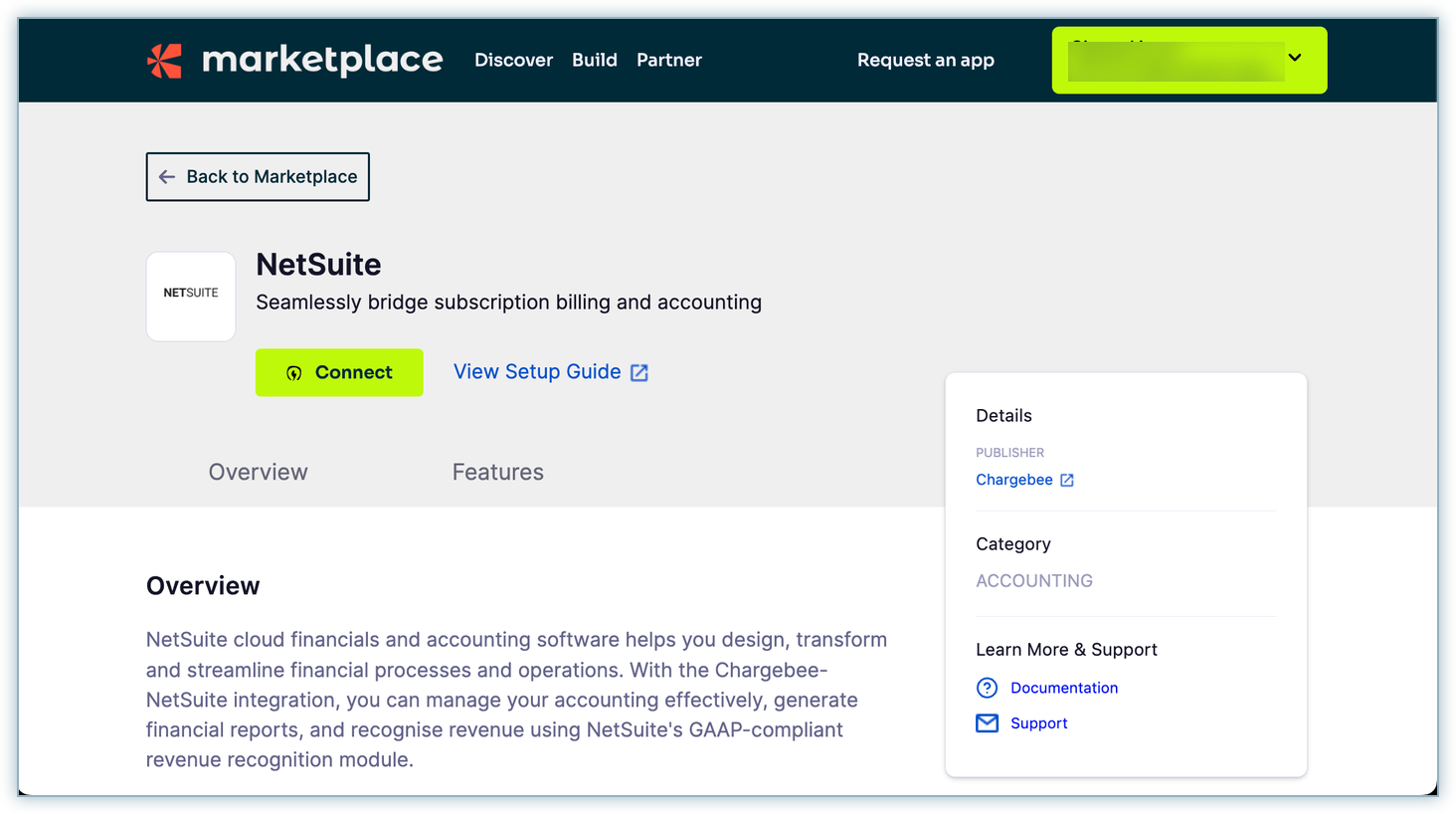
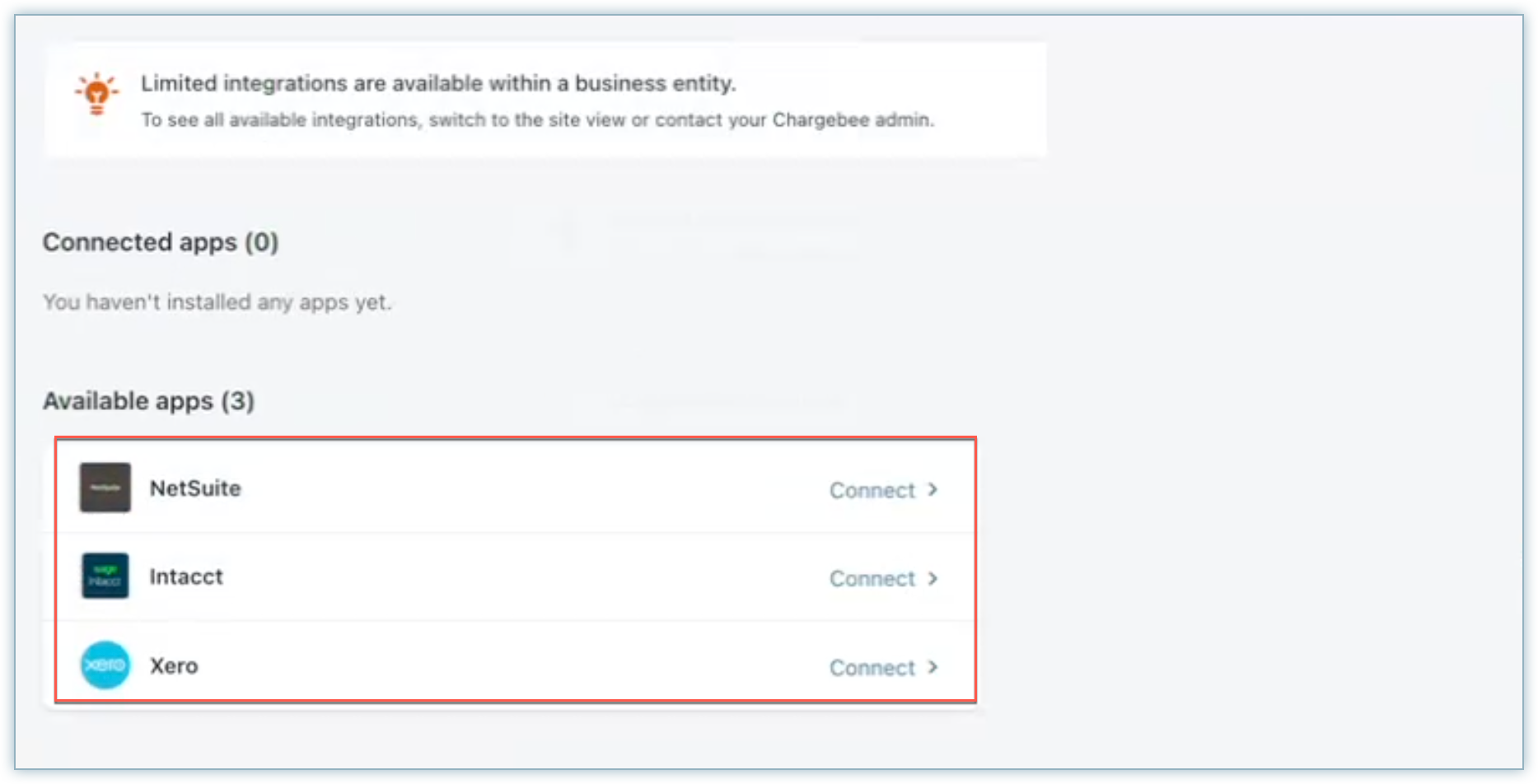
Click Connect to get started with the integration.

Enter the NetSuite login credentials in the pop-up connect box.
Once you have added the details, click Save.
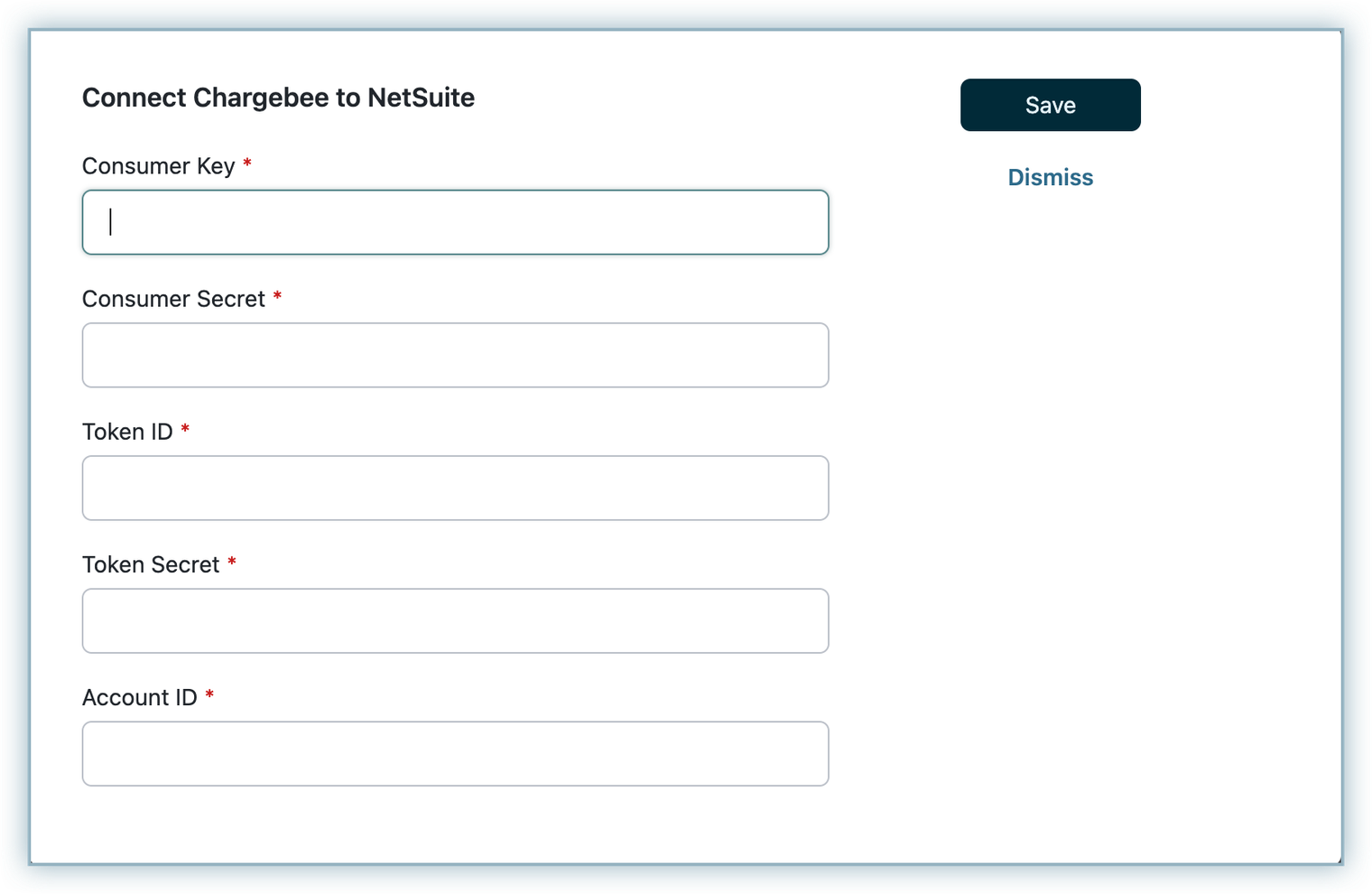
When the multi business entity feature is enabled, and you are connected at the site level with multiple business entities the following screen appears. Select from the list of business entities that you want to connect with and click Proceed.
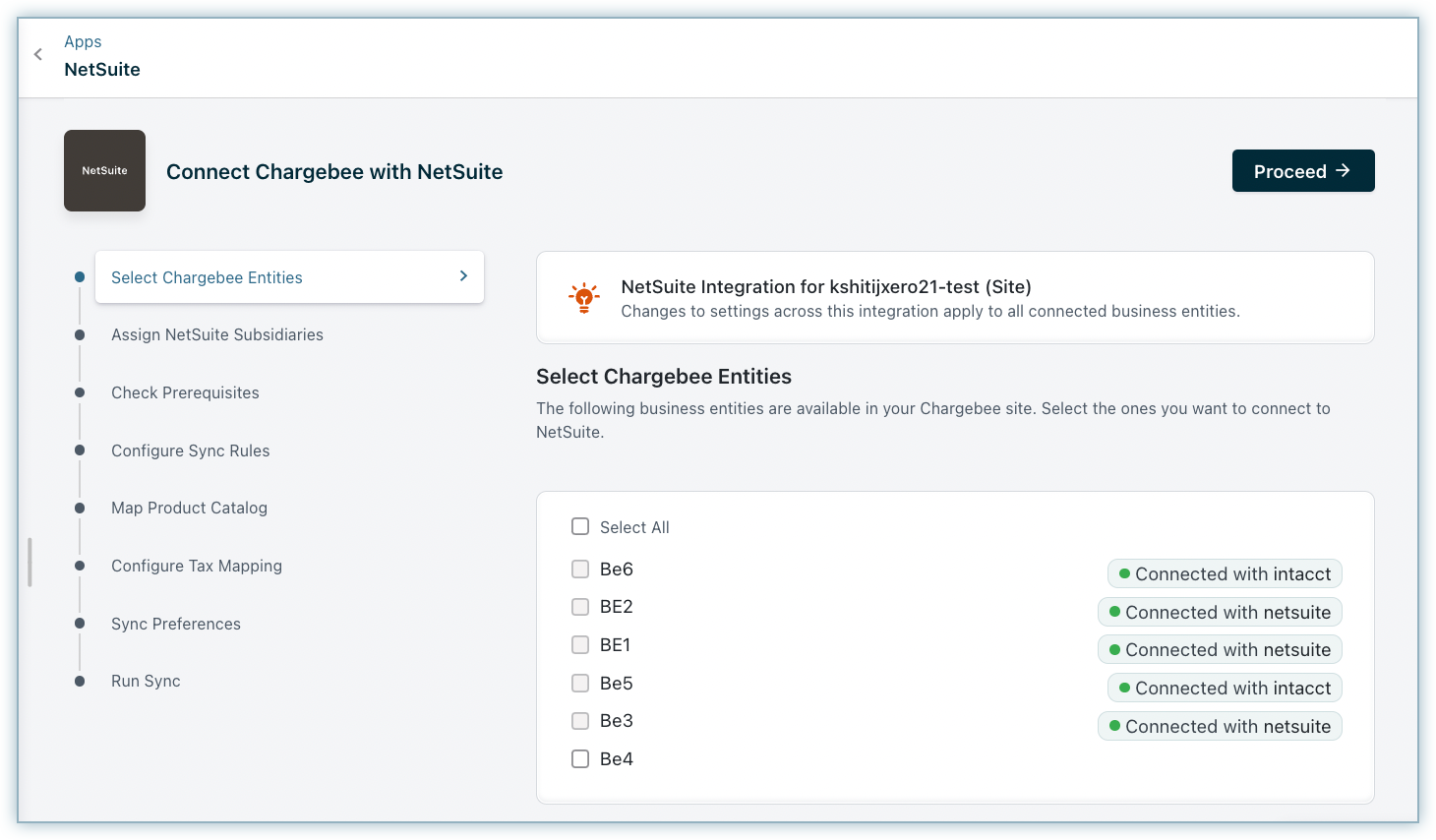
Map the NetSuite Subsidiary to each selected business entity to enable accounting information sync from Chargebee to NetSuite.
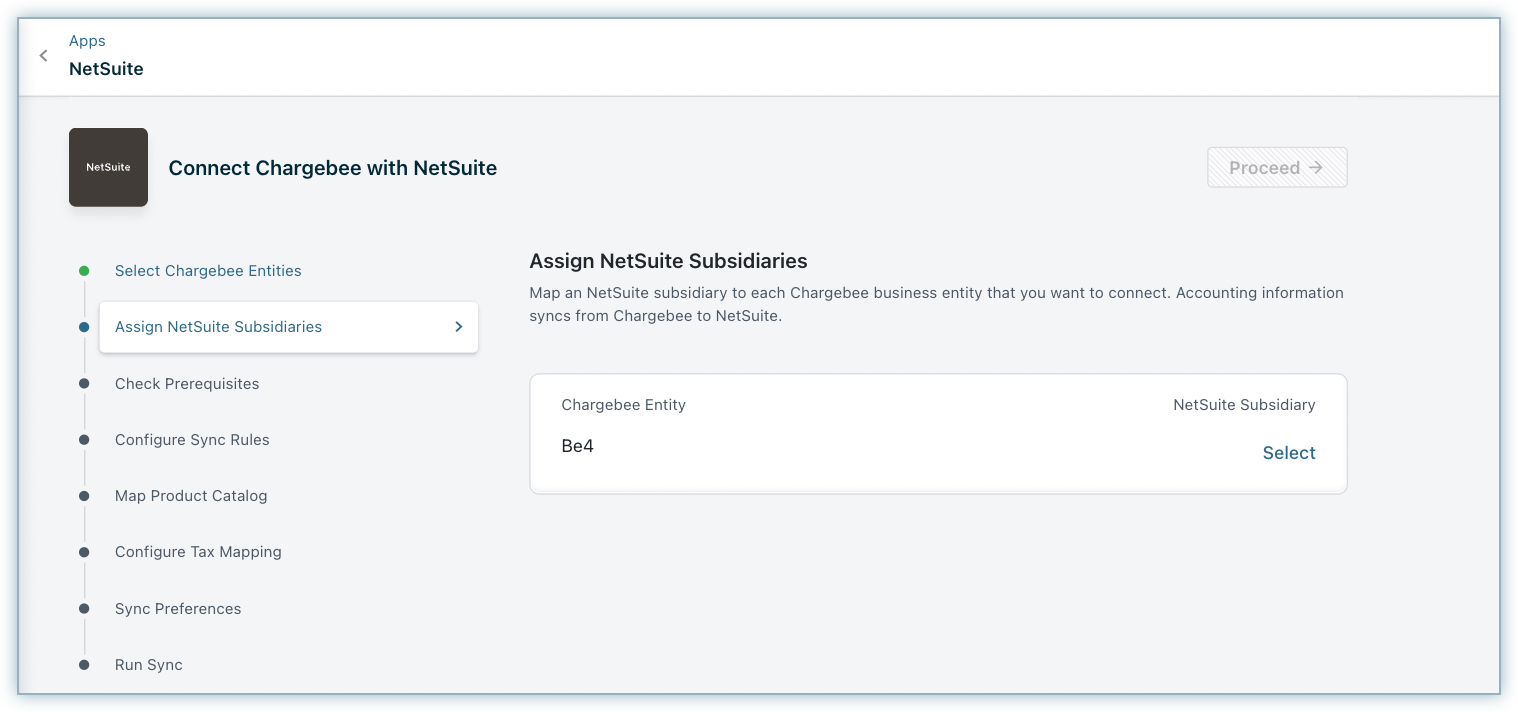
If you are connected at the entity level view, you can only assign one NetSuite Subsidiary.
Chargebee performs a list of checks in NetSuite. This prerequisite check verifies if the accounting codes, customers, and their currencies in NetSuite are available in Chargebee before proceeding with the integration.
Click Proceed to move to the next step.
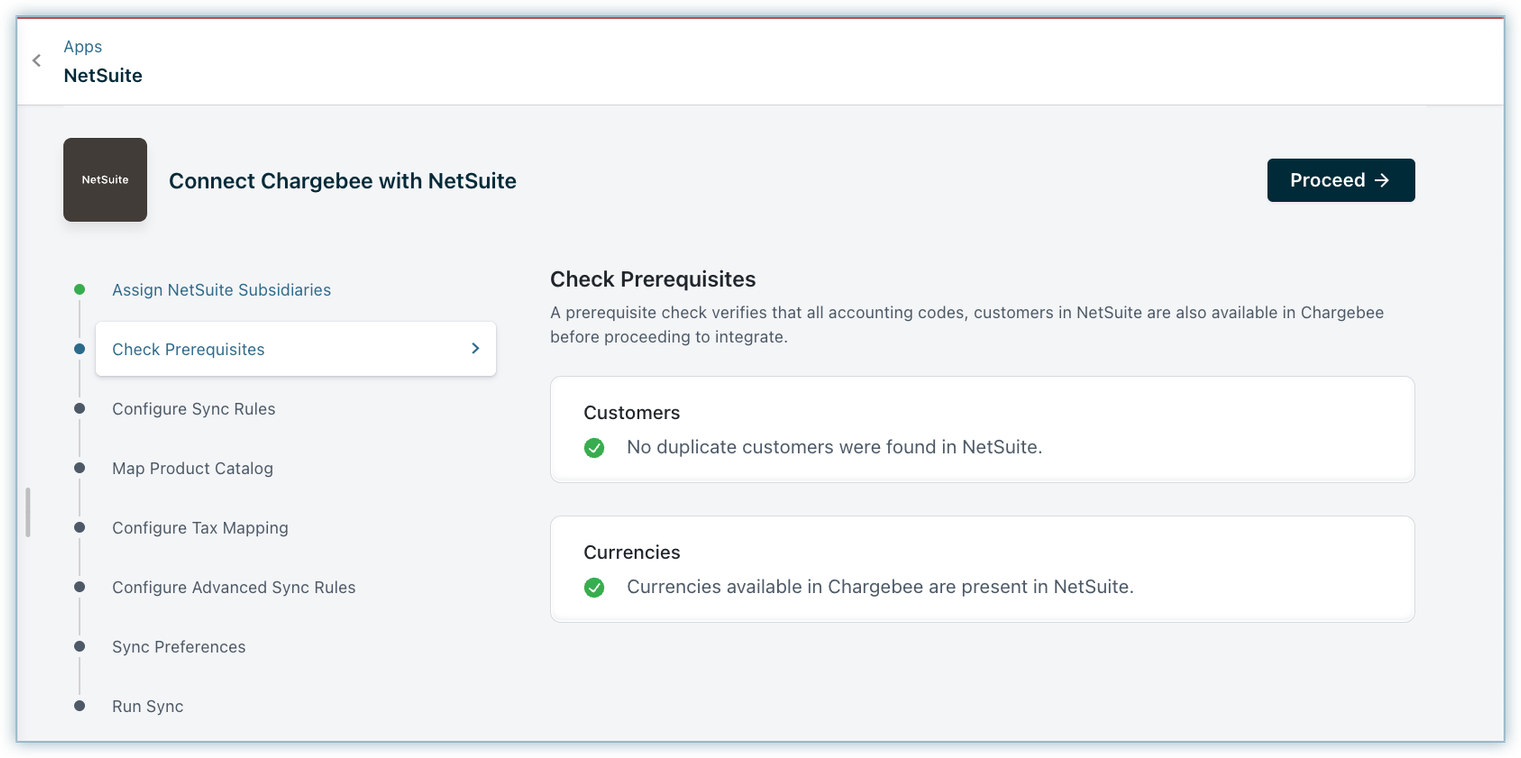
The following error message will be displayed if customer data already exists in NetSuite. In such cases, you can contact eap@chargebee.com.
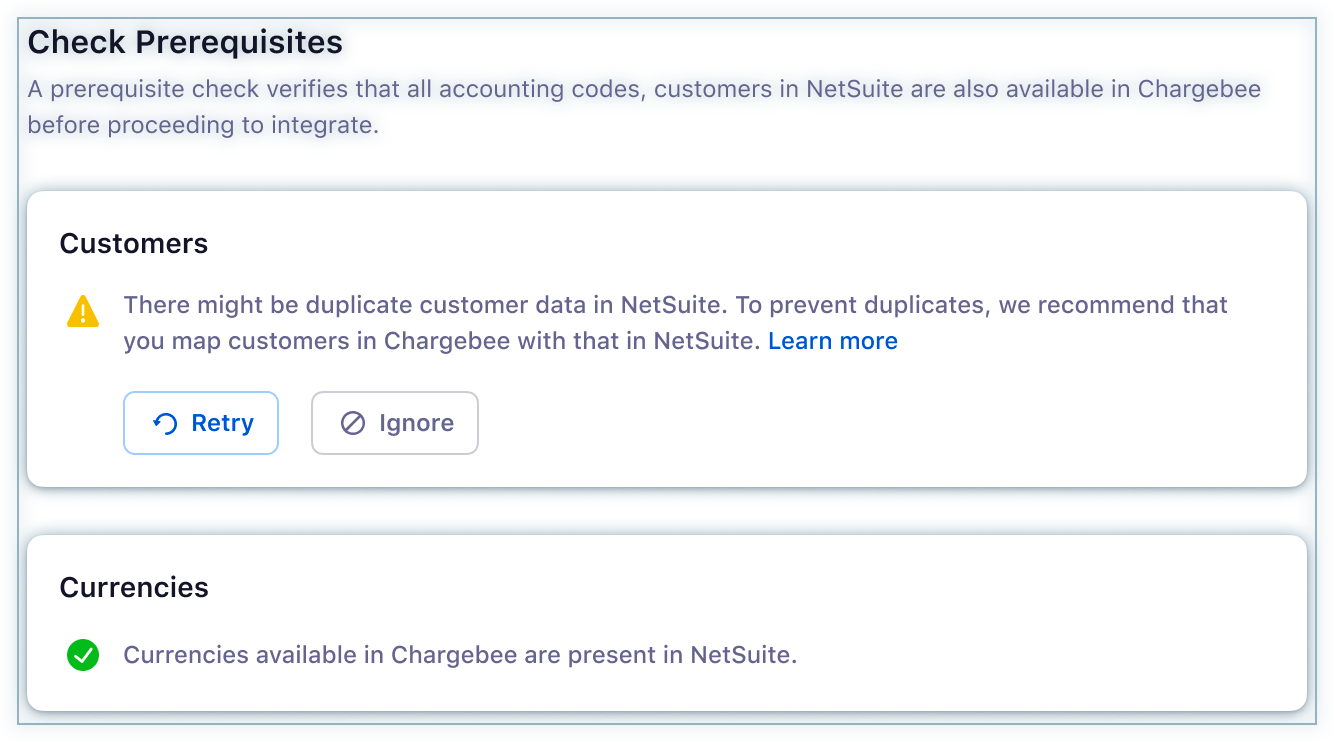
To ensure that the integration settings are common to all the connected business entities, you need to perform account mapping for payments, invoice line items, and refunds.
Business entities selected at the site level will share a common configuration.
Payment transactions recorded in Chargebee can be mapped to payment accounts in NetSuite. For reconciliation purposes, you can select a clearing or undeposited funds account. If you have multiple currencies, payment gateways, or payment methods enabled, you can choose specific payments or checking accounts.
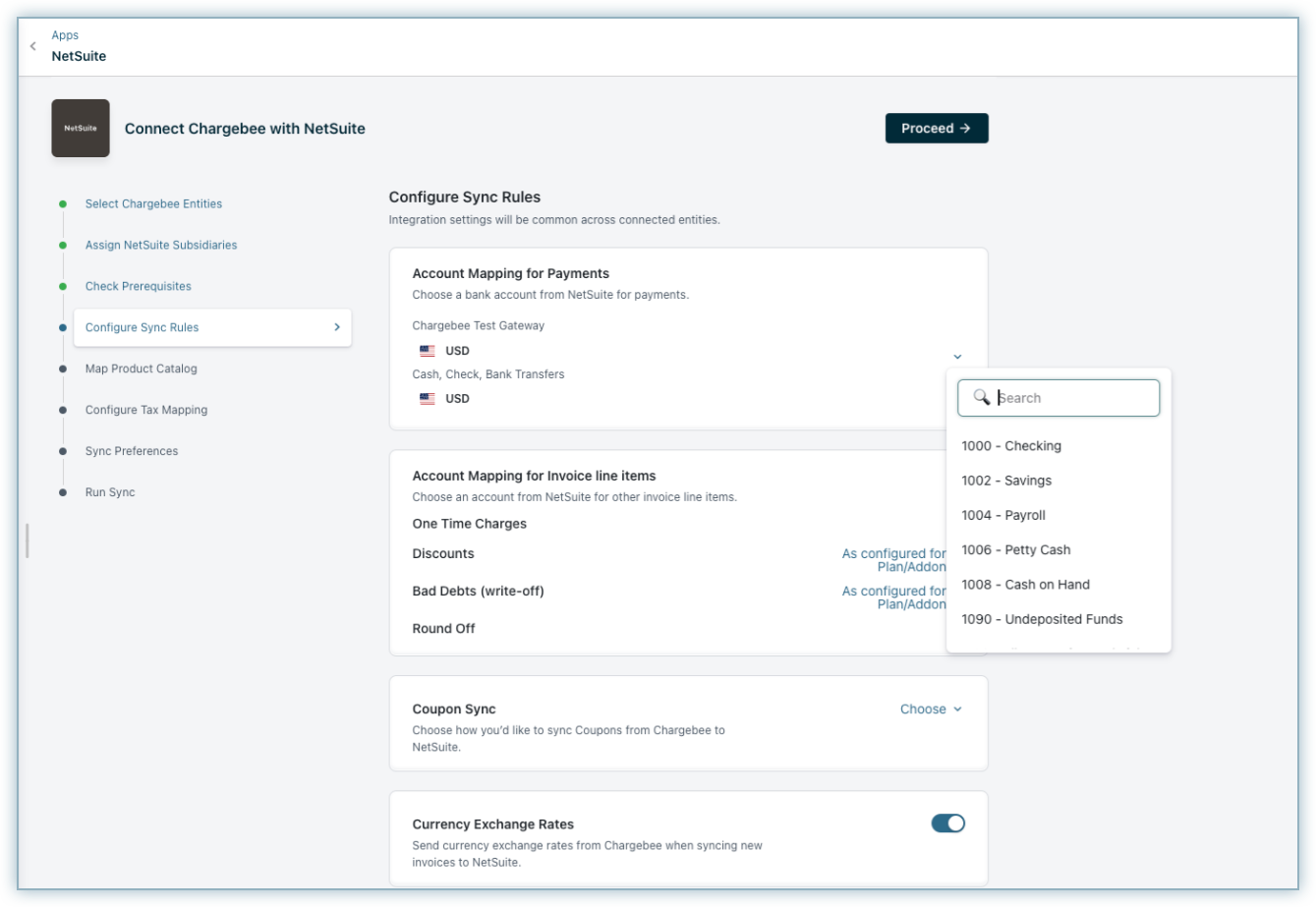
Account mapping for invoice line items involves assigning specific accounts or categories to each line item on an invoice.
Choose how you'd like to sync coupons from Chargebee to NetSuite. Refer to Coupon Sync for more information.
When the currency exchange rates are enabled, you can send currency exchange rates from Chargebee for transactions, invoices, or credit notes to NetSuite.
Offline Payment Sync offers flexibility for automatically syncing offline payments from Netsuite to Chargebee. You can allow sync to handle offline payments automatically or skip offline payments from sync and in that latter case, you need to manually record offline payments in Chargebee.

You have the option to map payment methods manually using the Map Manually option or let it be done automatically. If you choose Map Automatically, the sync will automatically match payment methods between Chargebee and NetSuite. If it doesn't find a relevant match, it will create a new payment method and use it automatically.
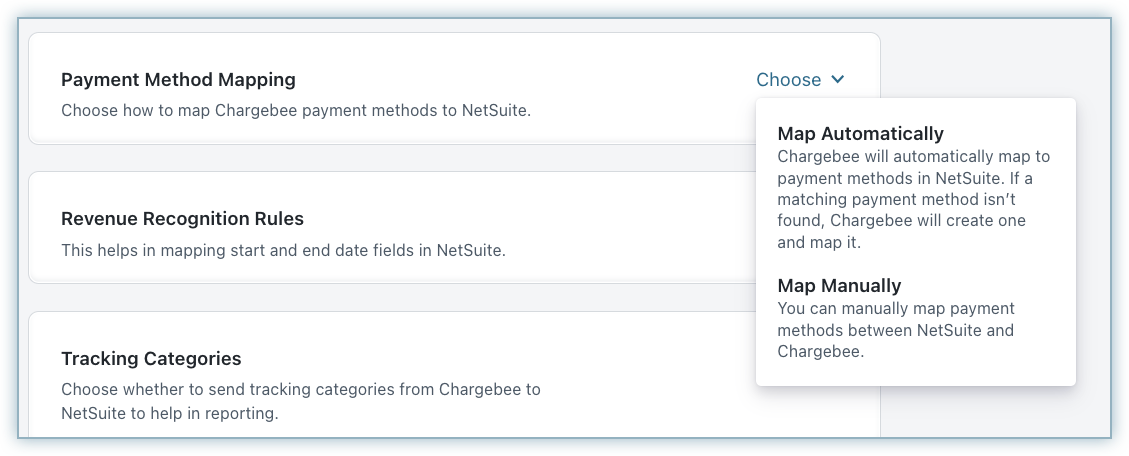
You can send revenue recognition information from Chargebee for Invoice line items when this Revenue Recognition Rules button is enabled.

You can send tracking category information from Chargebee for Invoice line items when the Tracking Categories button is enabled.
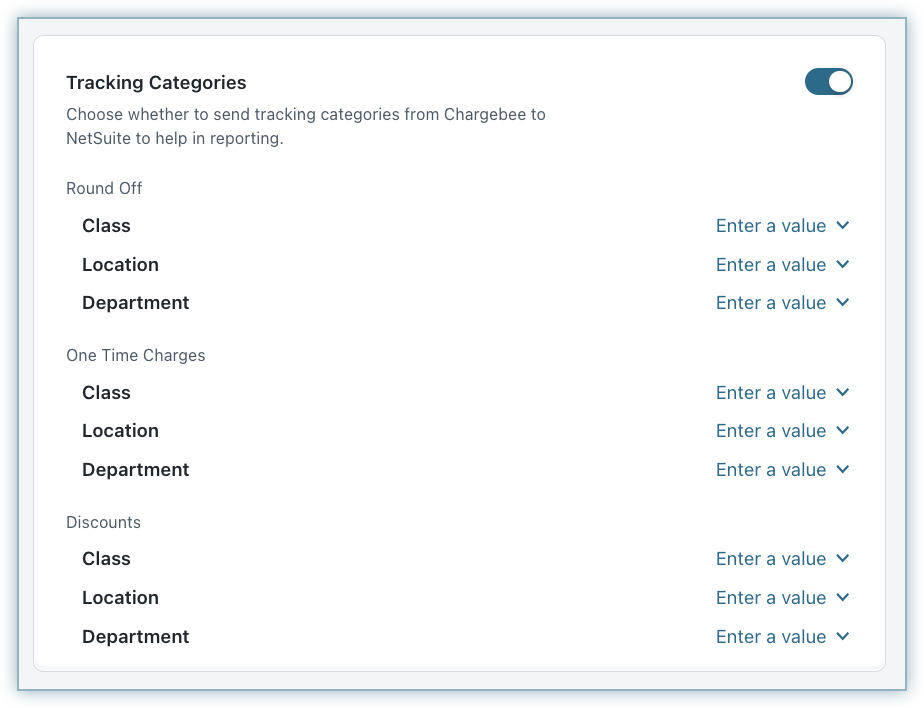
You can choose to identify duplicate customers in Netsuite when data is synced from Chargebee using the two options available in the Customer Duplicate Check. You can use the customer's email or ID to check for duplicates.

Within Chargebee, items are configured at the site level, and different accounting attributes, such as accounting code, SKU identifier, and tracking category cannot vary for each business entity. To enable distinct accounting fields for each business entity, you can employ product catalog mapping, which allows you to assign the necessary data at the business entity level according to specific requirements.
The Map Product Catalog feature is deprecated for test sites, and the product catalog step will no longer be available except for sites using Multi Business Entity with Product Catalog. Deprecation for all live sites is also planned. New users should configure price points for the plan, addon, and charge under Accounting Details.
You can upload a CSV file containing mapping details between products and business entities. Within these mappings, you can specify accounting codes for each entry.
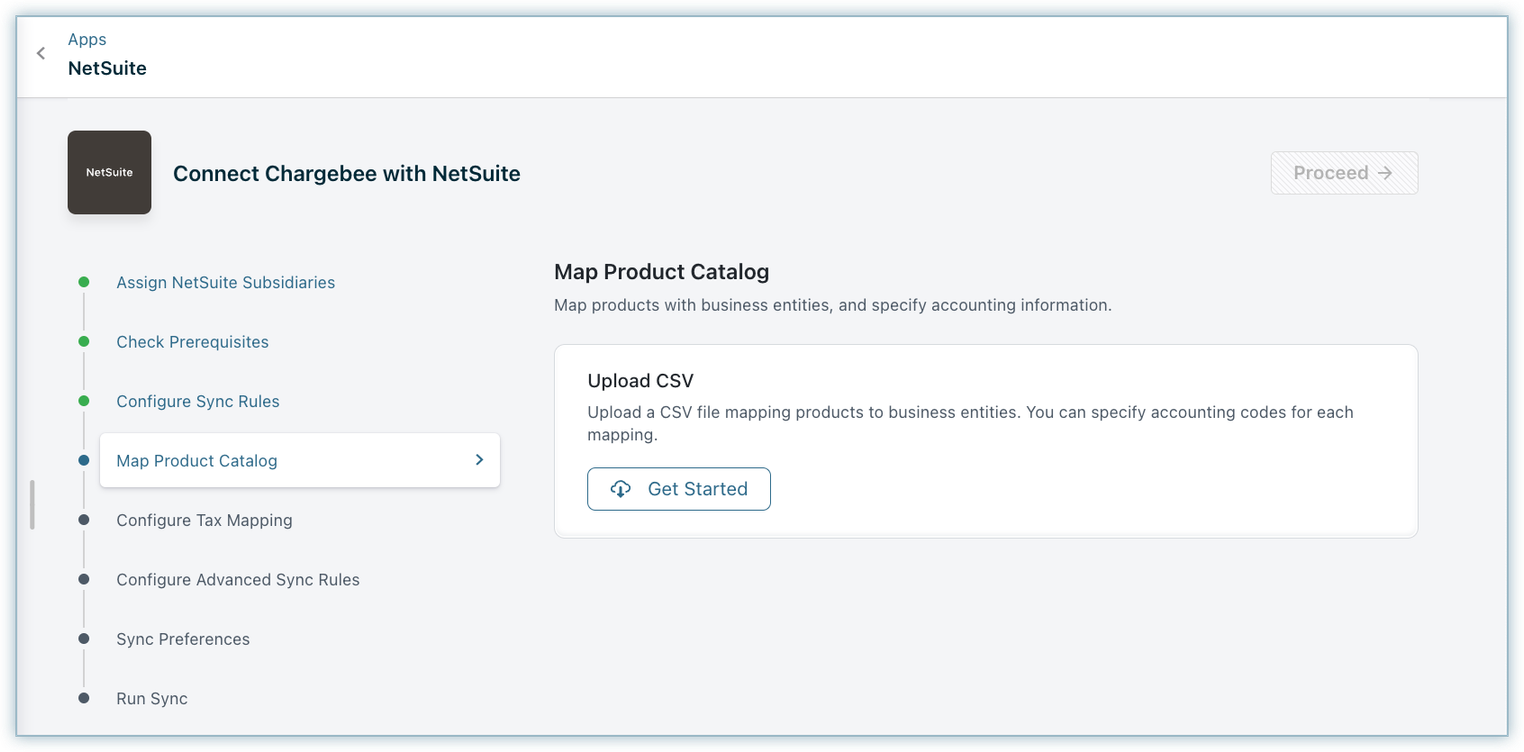
You can download the sample CSV template using this button.
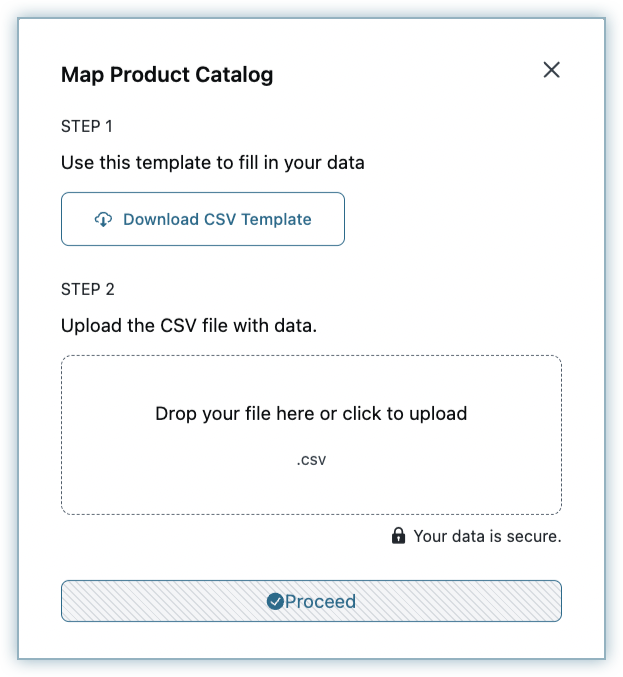
The sample downloaded CSV file contains the following fields:
| CSV Field Name |
Description |
Additional Info |
|---|---|---|
| PRODUCT_ID |
Unique identifier for Chargebee's item prices. |
|
| PRODUCT_NAME |
Name of the Item price in Chargebee's Product catalog. |
|
| SKU |
SKU of the product |
This field is used to map the existing items from NetSuite to the respective plan/addon in Chargebee. It can be used as an alternative name for plan/addon and its character limit should not exceed 30 characters. |
| ACC_CODE |
Accounting code associated with the item |
The Accounting code field should be filled for all the plans and addons. |
| ACCOUNTING_FIELD1 |
Class |
If you've classified Dimensions for your products in NetSuite, and would like to sync data specific to it, enter the information here |
| ACCOUNTING_FIELD2 |
Location |
If you've classified Dimensions for your products in NetSuite, and would like to sync data specific to it, enter the information here |
| ACCOUNTING_FIELD3 |
Department |
If you've classified Dimensions for your products in NetSuite, and would like to sync data specific to it, enter the information here |
| ACCOUNTING_FIELD4 |
Revenue Recognition Rule Id |
If you've configured Rev Rec for your products in NetSuite, and would like to sync data specific to it, enter the information here |
| BE_NAME |
Name of the business entity |
This will be displayed in case of site level view. In case of the Entity Level view only the respective BE will be displayed |
In case of any errors during validation, an error message is displayed, which can be fixed by re-uploading the file with the correct mapping.
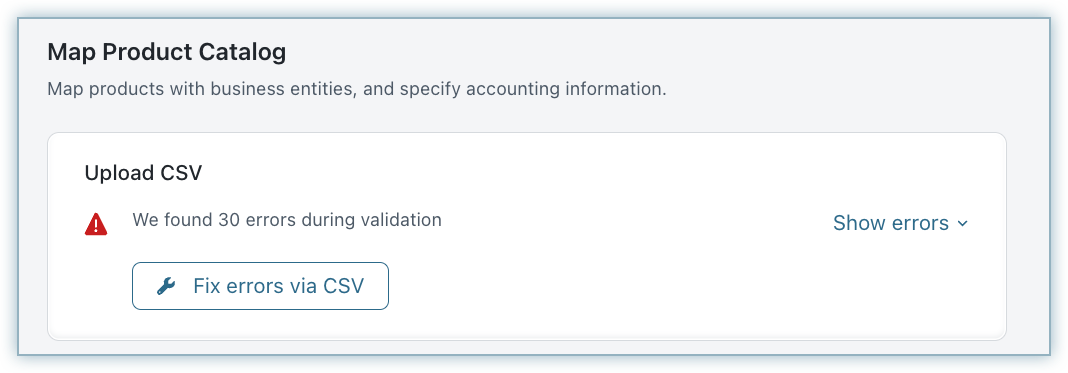
Upon successful validation, you can see the successfully mapped records as shown below.
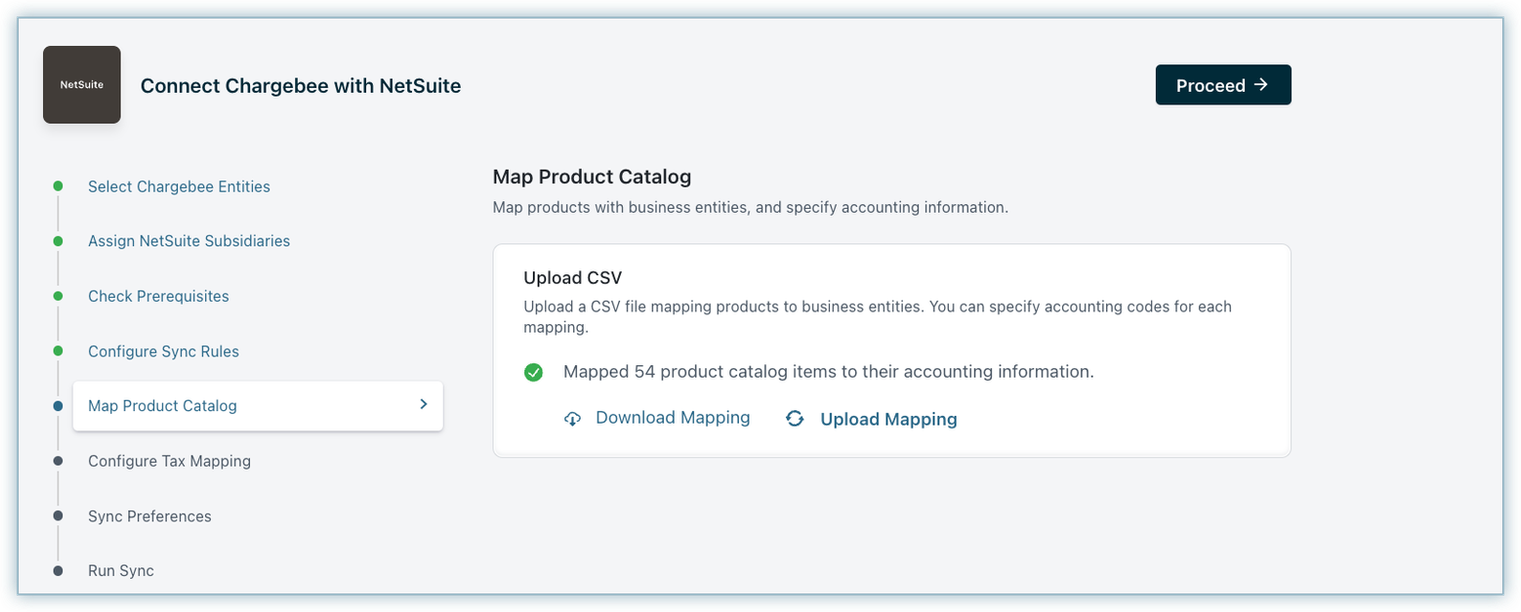
You can choose how taxes are to be computed, and also set up tax sync from Chargebee to NetSuite if required. Enable the Sync tax information from Chargebee to NetSuite.
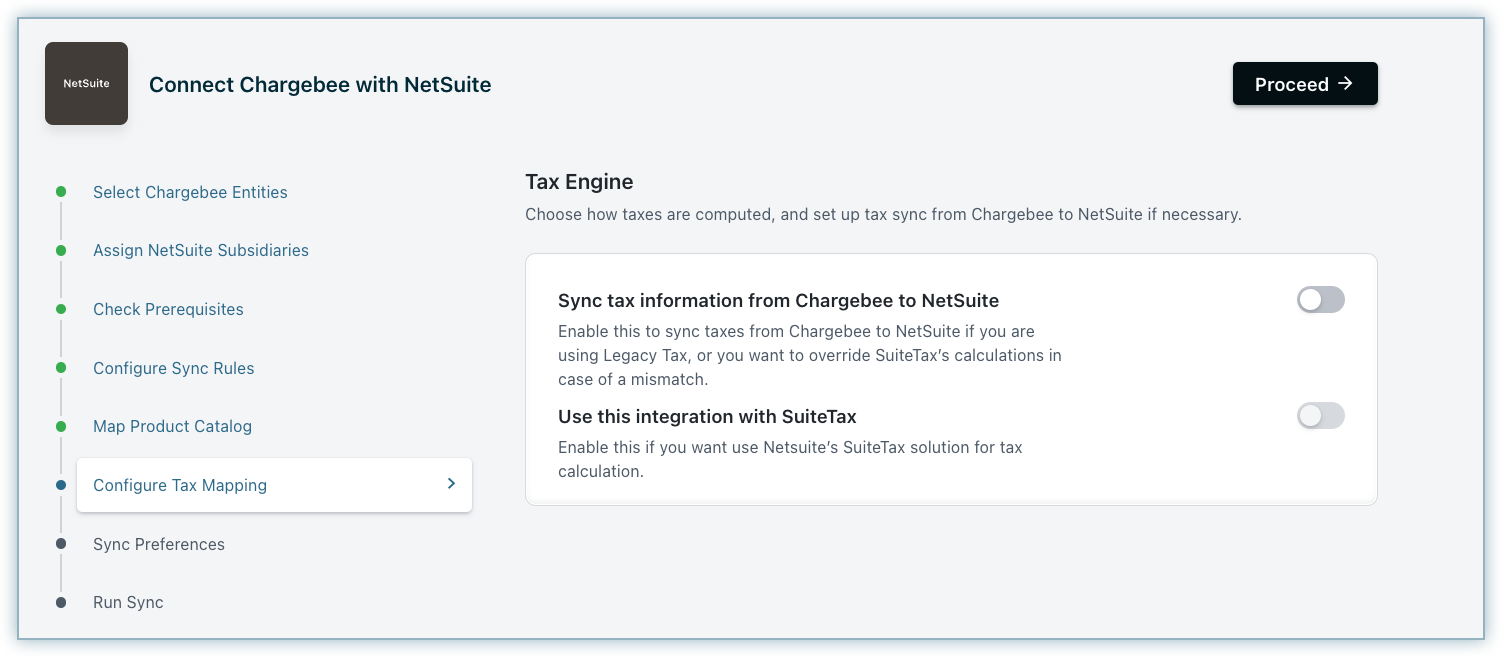
You will see the Retrieve latest mapping button, which will retrieve the latest tax codes/tax groups used for tax mapping. This will run for some time to fetch the latest tax information that can be used for default tax mapping.
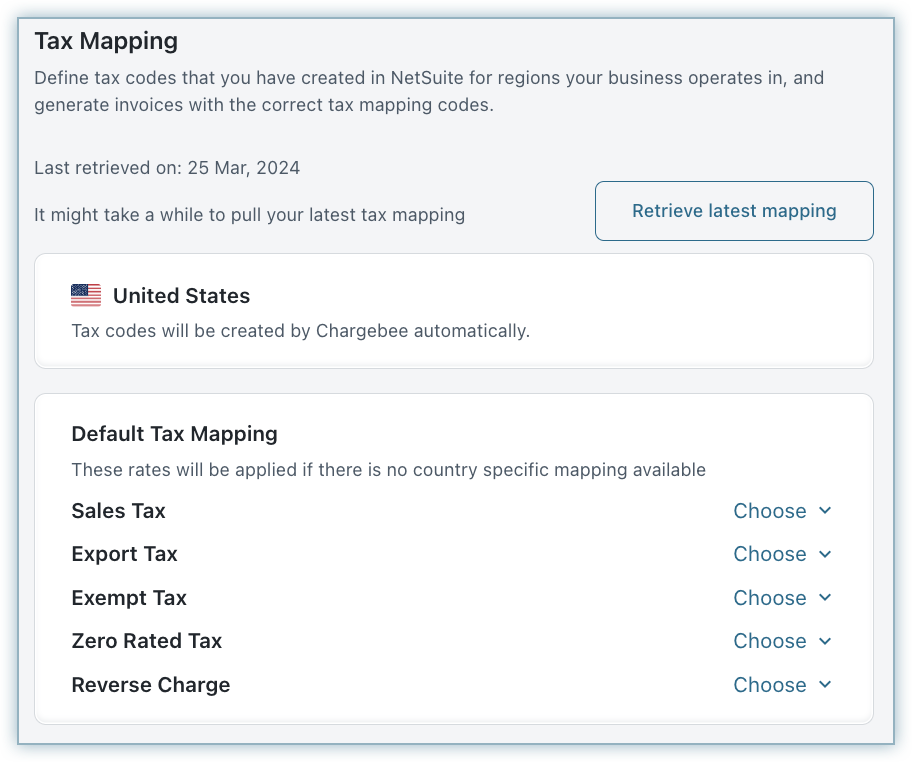
This is an additional non-mandatory sync rule step. You can choose to skip it by clicking Proceed.
This value acts as a common prefix to all object IDs syncing from Chargebee to NetSuite. When syncing objects from multiple systems (such as another Chargebee account or a CRM) to a NetSuite account, this prefix helps you identify objects from this account.
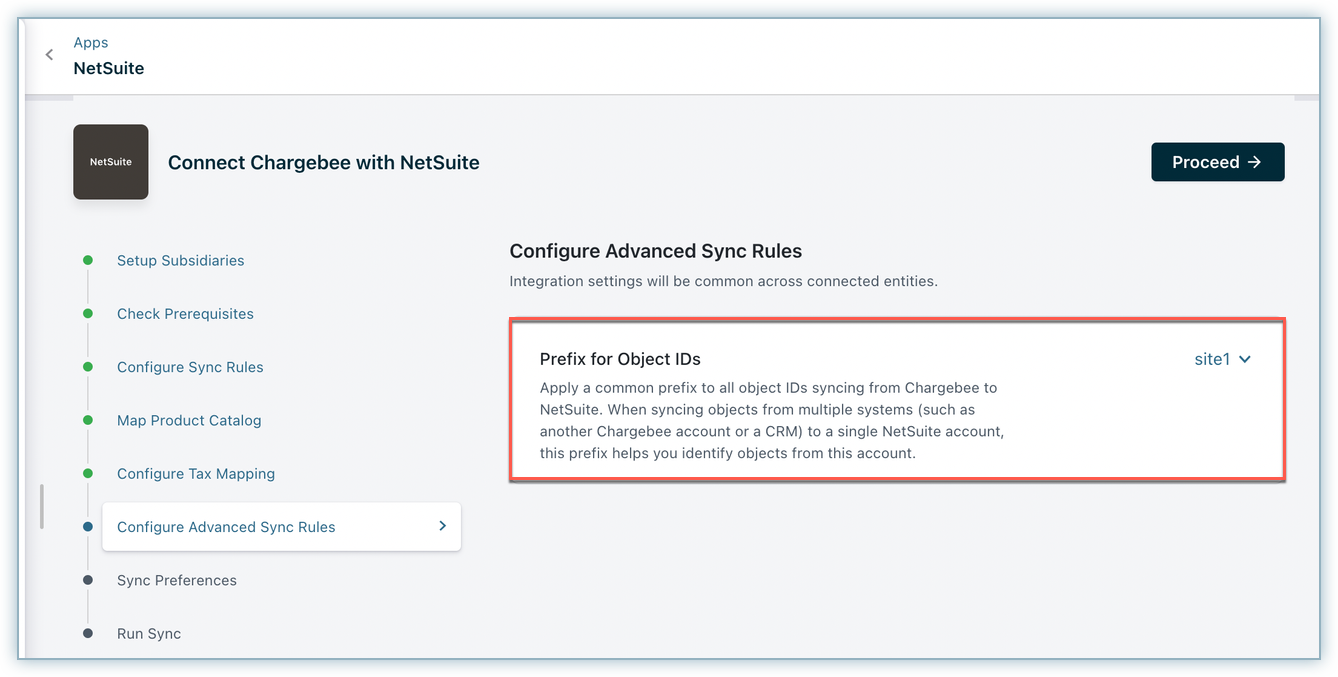
You can choose to sync invoices from Chargebee to NetSuite from a particular date by selecting the relevant date from the drop-down.
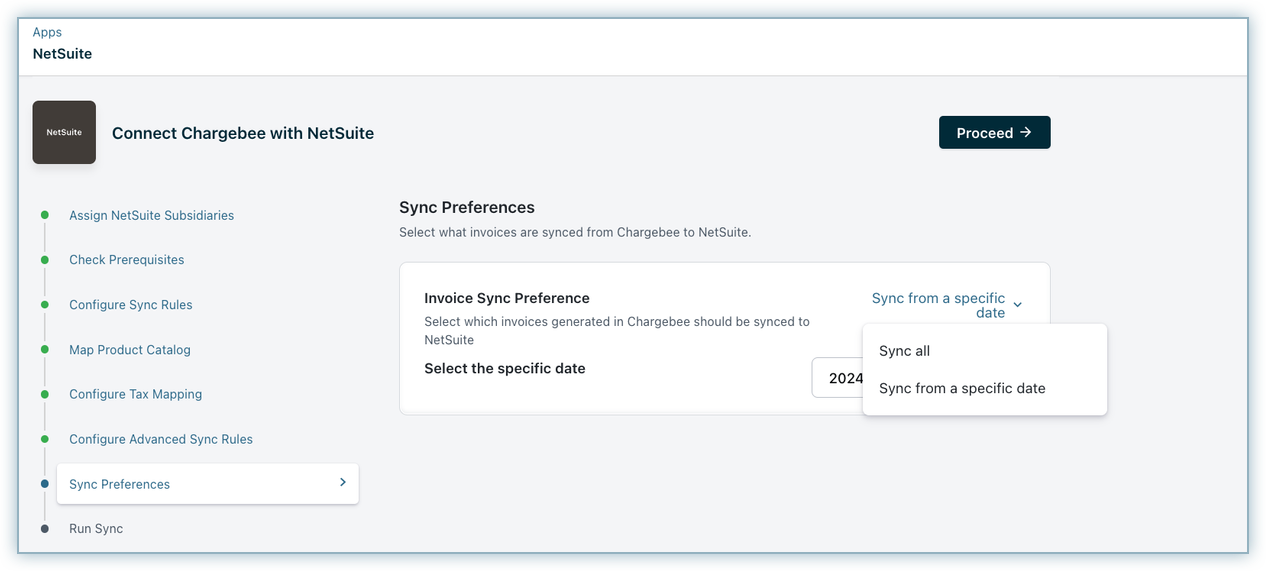
Once the configuration is complete, click Run Initial Sync to begin the sync. Chargebee will sync the first 10 invoices, to ensure that mapping, conventions, and sync criteria align with your requirements.
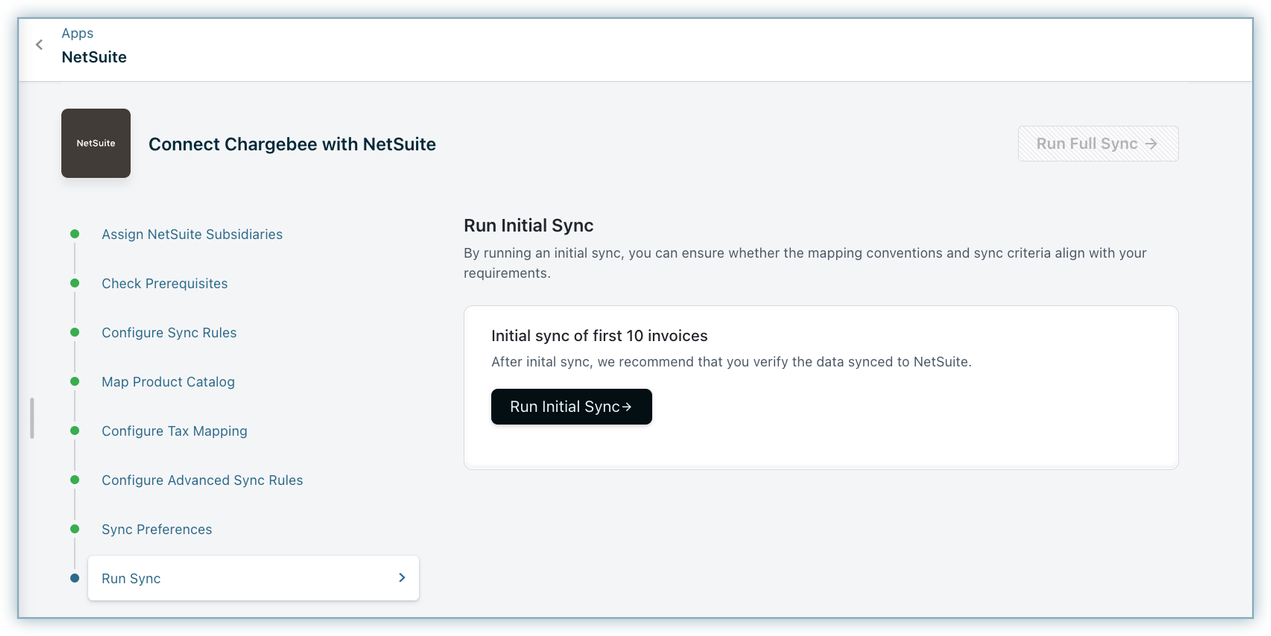
You need to review these invoices in NetSuite. If the sync works as expected, you can click the Run Full Sync.
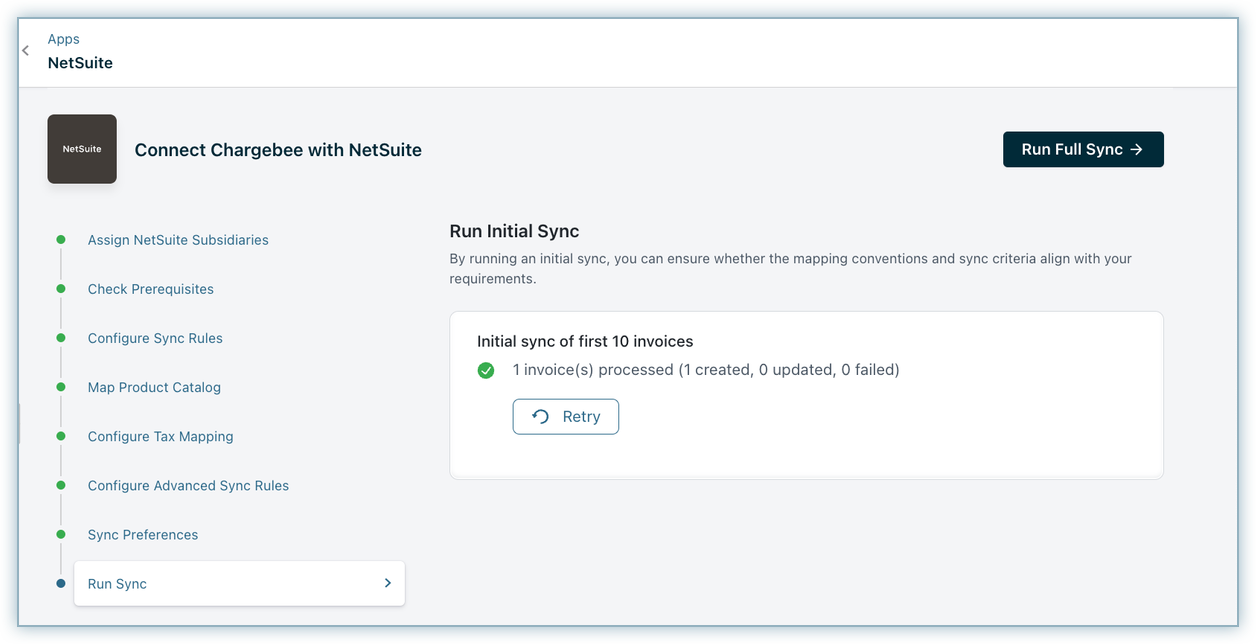
On triggering Run Full Sync the sync dashboard is displayed where you can view or manage settings. This screen is displayed for the business entity that is independently connected at the entity level, not through the site level.
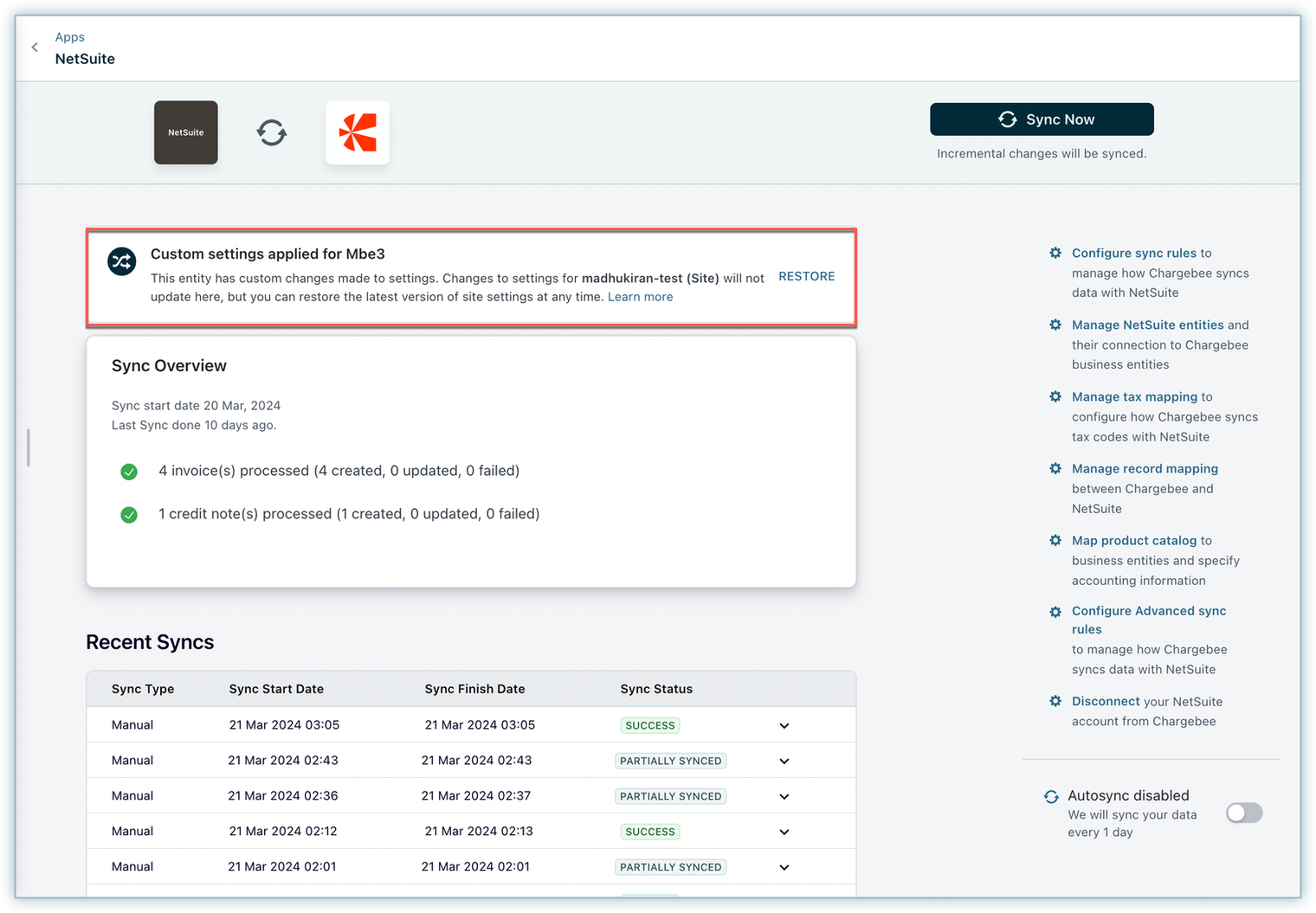
This screen is displayed for the business entity that is connected at the entity level through the site level.
Settings cannot be edited at the entity level if already connected through the site level. Changes can be made only at the site level.
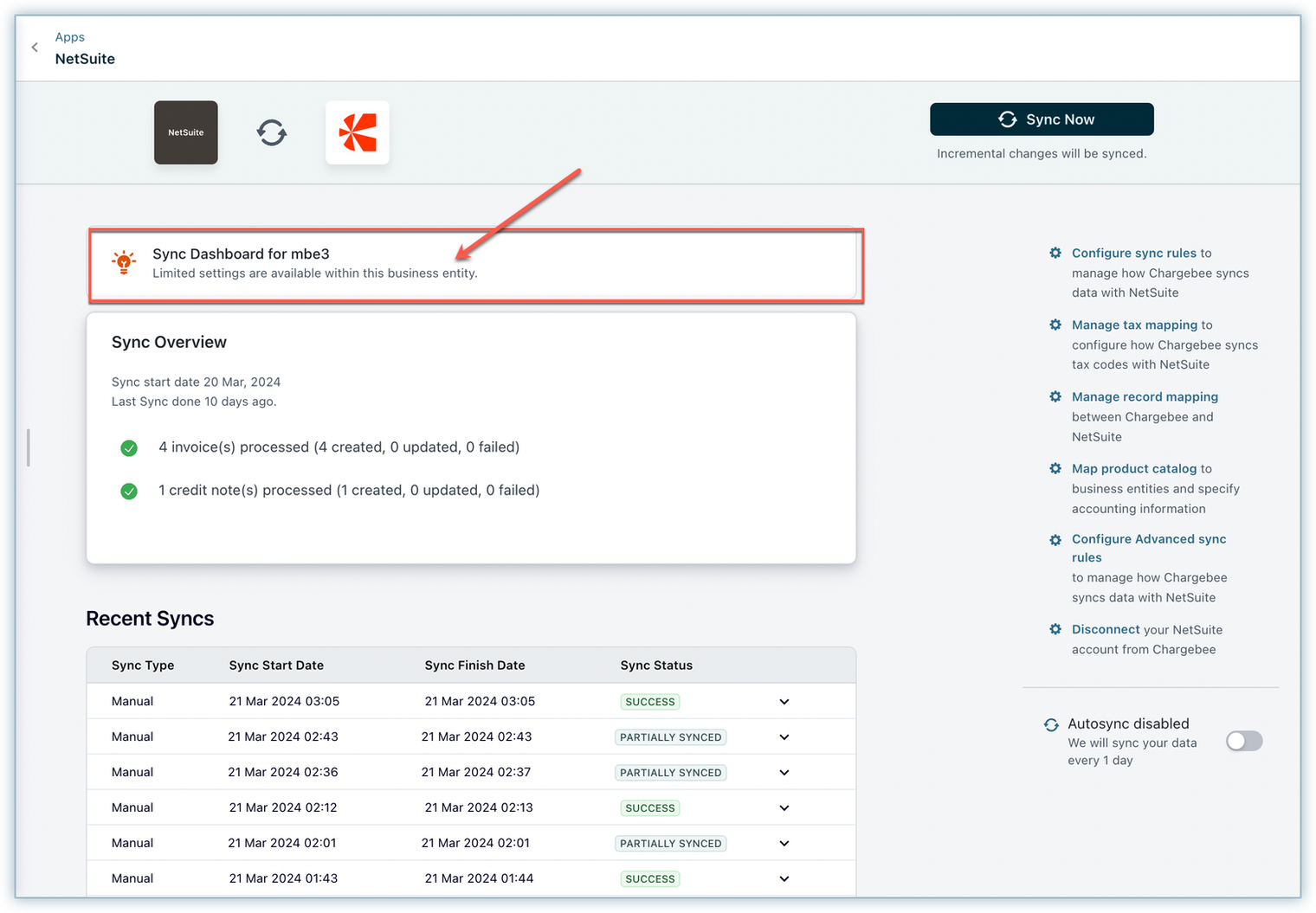
This screen is displayed at the site-level view where you can edit the settings.
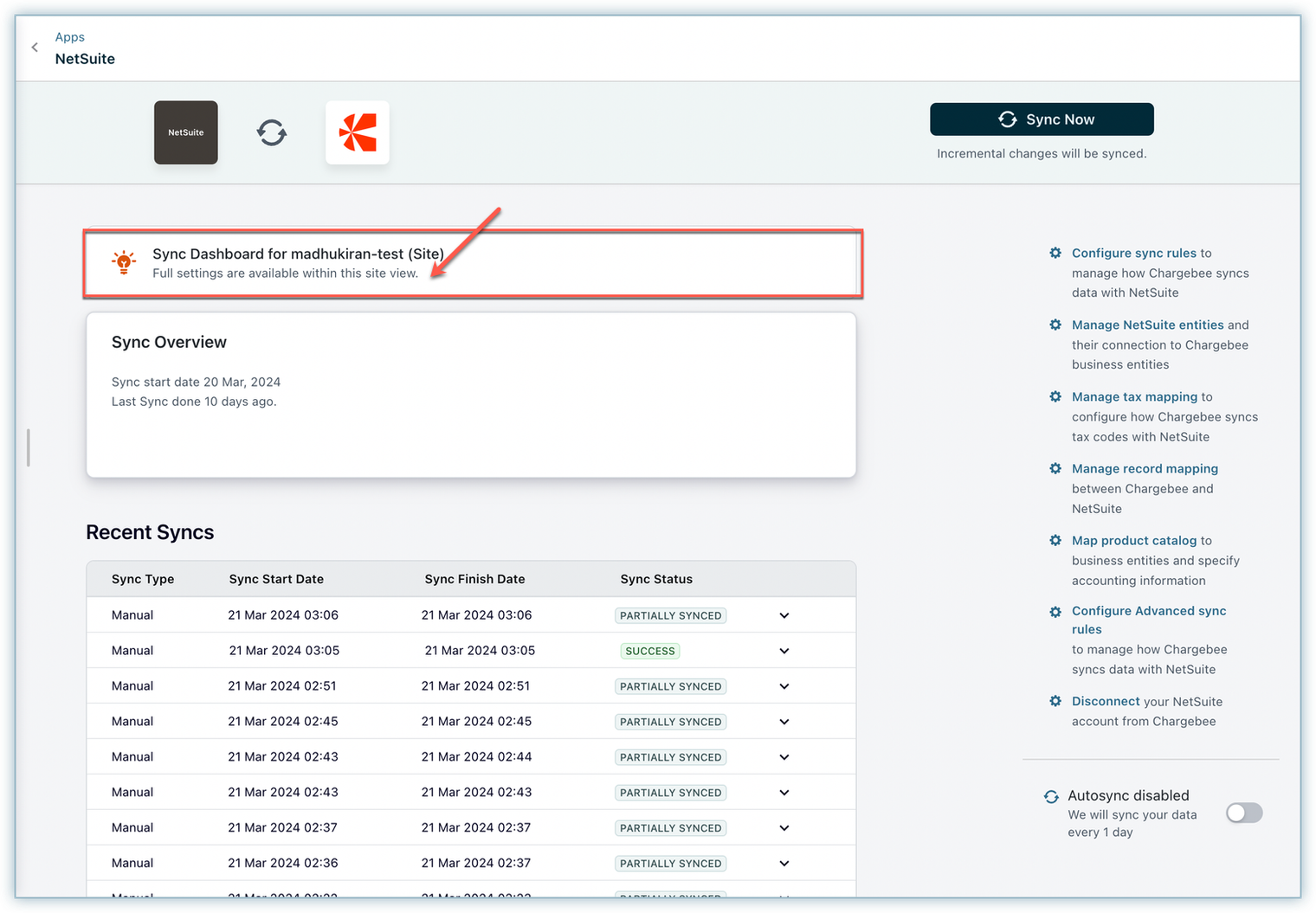
After setting up the integration, you can configure the daily schedule to sync all the information to NetSuite automatically. Invoices and related information will be synced once every 24 hours. You can choose to disable auto-sync if required.
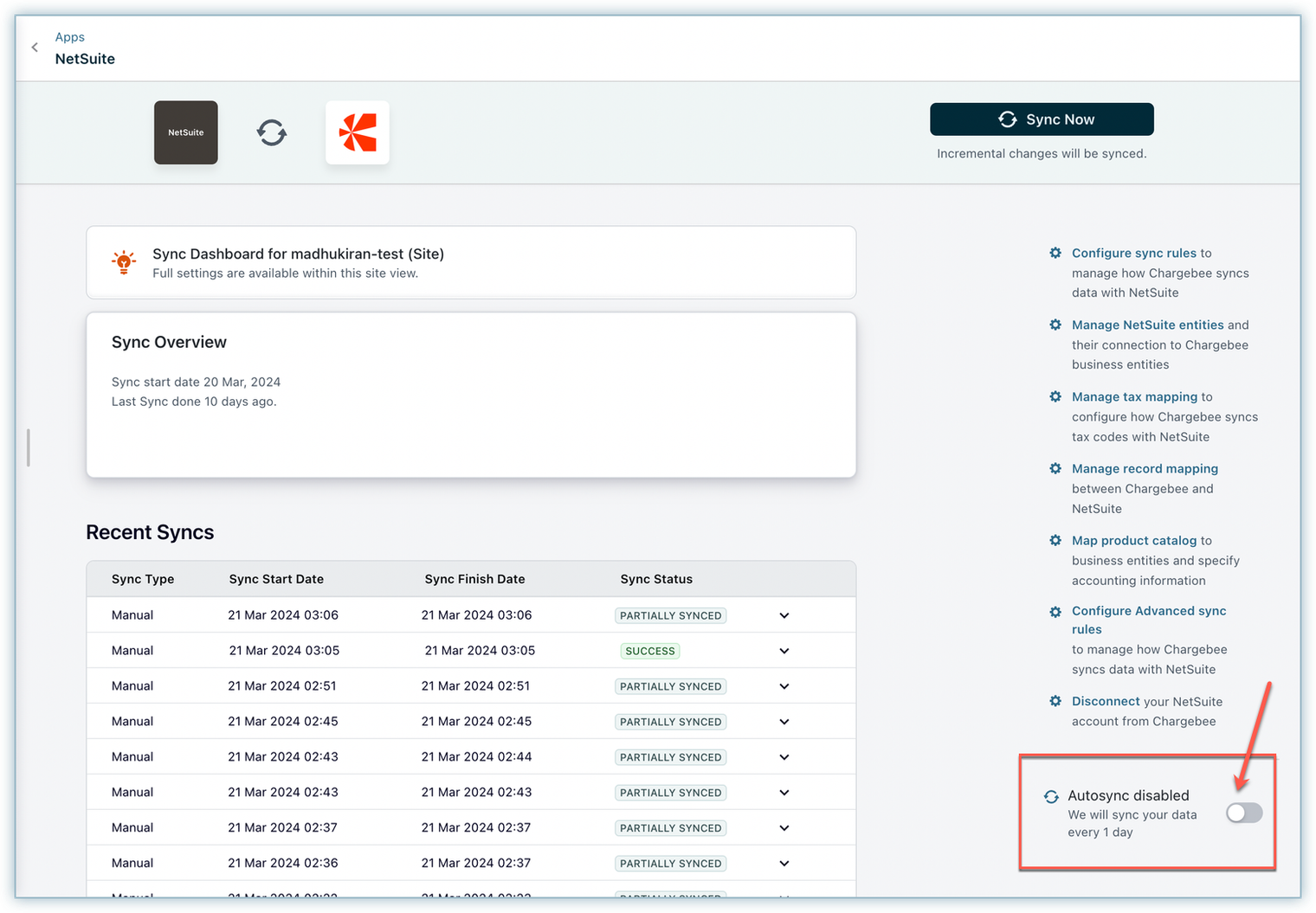
You have to enable auto sync at the site level only then entity level auto sync will be honoured.
For on-demand sync, you can sync data from Chargebee to NetSuite immediately.
You can edit the configurations or GL Account mapping provided during the setup process.
For any new business entities created in Chargebee, add a mapping at the site level if they need to share configurations. If you prefer to have separate site settings, you can connect the entity independently.
You can add/update the mappings for the Chargebee records (Invoices, Customers, Credit notes, and Transactions.)
Adjust the tax mapping configured during the setup process. If new tax regions have been added in Chargebee settings, update the tax mapping in this section accordingly.
Manage and update the product catalog.
Allows you to modify advanced sync rules. This new value will be applicable for further sync that will run, it will not modify any existing records.
On disconnecting at the site level it'll disconnect all the entities, Disconnecting at the entity level will only disconnect at a specific entity level.
